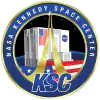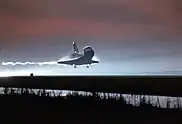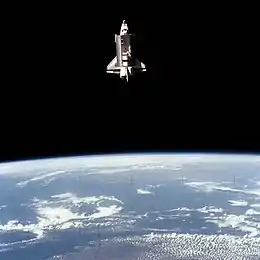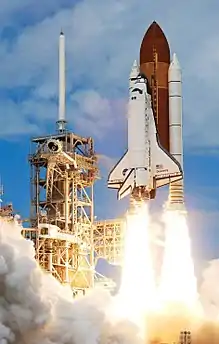Shuttle Landing Facility
The Shuttle Landing Facility (SLF) (IATA: QQS, ICAO: KTTS, FAA LID: TTS) is an airport located on Merritt Island in Brevard County, Florida, United States. It is a part of the Kennedy Space Center and was used by Space Shuttle for landing until July 2011. It was also used for takeoffs and landings for NASA training jets such as the Shuttle Carrier Aircraft and for civilian aircraft.[1][2]
Shuttle Landing Facility | |||||||||||
|---|---|---|---|---|---|---|---|---|---|---|---|
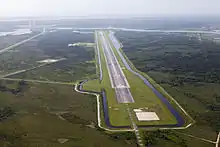 Aerial view of Shuttle Landing Facility in 2012 | |||||||||||
| Summary | |||||||||||
| Airport type | Government/Private | ||||||||||
| Owner | NASA | ||||||||||
| Operator |
| ||||||||||
| Location | Merritt Island, Florida | ||||||||||
| Opened | 1976 | ||||||||||
| Built | 1974 | ||||||||||
| Occupants | Kennedy Space Center | ||||||||||
| Elevation AMSL | 10 ft / 3 m | ||||||||||
| Coordinates | 28.615°N 80.6945°W | ||||||||||
| Map | |||||||||||
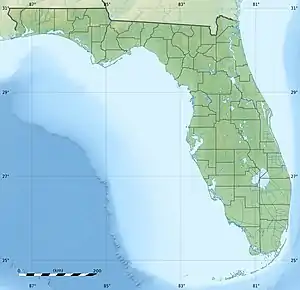 SLF Location of airport in Florida | |||||||||||
| Runways | |||||||||||
| |||||||||||
Starting in 2015, Space Florida manages and operates the facility under a 30-year lease from NASA. Private companies have been utilizing the SLF for its unique properties since 2011 and will continue to do so via Space Launch Florida.[3]
Facilities
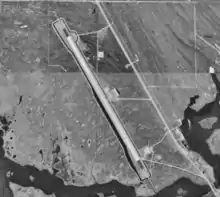
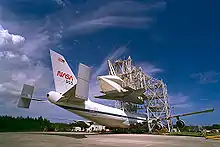
The Shuttle Landing Facility covers 500 acres (2,000,000 m2) and has a single runway, 15/33. It is one of the longest runways in the world, at 15,000 feet (4,600 m), and is 300 feet (91 m) wide (Despite its length, astronaut Jack R. Lousma stated that he would have preferred the runway to be "half as wide and twice as long"[4]).[1] Additionally, the SLF has 1,001 feet (305 m) of paved overruns at each end. The Mate-Demate Device (MDD), for use when the Shuttle was transported by the Shuttle Carrier Aircraft, was located just off the southern end of the runway.[1]
The runway is designated runway 15, or 33, depending on the direction of use. The runway surface consists of an extremely high-friction concrete strip designed to maximize the braking ability of the Space Shuttle at its high landing speed, with a paving thickness of 16.0 inches (40.6 cm) at the center.[1] It uses a grooved design to provide drainage and further increase the coefficient of friction.[1] The original groove design was found to actually provide too much friction for the rubber used in the Shuttle's tires, causing failures during several landings. This issue was resolved by grinding down the pavement, reducing the depth of the grooves significantly.
A local nickname for the runway is the "gator tanning facility", as some of the 4,000 alligators living at Kennedy Space Center regularly bask in the sunlight on the runway.[5]
The landing facility is managed by contractor EG&G, which provides air traffic control services, as well as managing potential hazards to landing aircraft, such as bird life. The Bird Team kept the facility clear of both local and migratory birds during Shuttle landings using pyrotechnics, blank rounds fired from shotguns and a series of 25 propane cannons arranged around the facility.[6]
History and usage
Space Shuttle
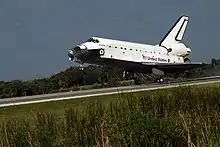
Columbia was the first Shuttle to arrive at the SLF via the Shuttle Carrier Aircraft on March 24, 1979.[7]
The runway was first used to land a Space Shuttle on February 11, 1984, when the STS-41-B mission returned to Earth. This also marked the first landing of a spacecraft at its launch site. Prior to this, all Shuttle landings were performed at Edwards Air Force Base in California (with the exception of STS-3, which landed at White Sands Space Harbor) while the landing facility continued testing and Shuttle crews developed landing skills at White Sands and Edwards, where the margin for error is much greater than SLF and its water hazards.[8] On September 22, 1993, Discovery was the first Space Shuttle to land at night at the SLF on STS-51. A total of 78 Space Shuttle missions landed at the SLF.[7]
The final landing of a Space Shuttle occurred on July 21, 2011 by Atlantis for STS-135. Discovery and Endeavour took off from the SLF on top of the Shuttle Carrier Aircraft for museums in Washington, D.C. and Los Angeles.
Boeing X-37B
.jpg.webp)
In January 2014 it was announced that Boeing would lease the Orbiter Processing Facility at Kennedy Space Center to enable the U.S. Air Force to efficiently land, recover, refurbish, and re-launch the X-37B uncrewed spacecraft.[9]
In October 2014, NASA signed agreement for the use of the facility, and Boeing upgraded the OPF-1 for the X-37B program.[10]
The X-37B (OTV-4 mission) first used Kennedy Space Center's Shuttle Landing Facility on May 7, 2017 at 11:47 UTC.[11][12]
Project Morpheus testing
In 2012, NASA's Johnson Space Center's Project Morpheus's first vehicle arrived at KSC. Prior to arrival at KSC and throughout the project, Morpheus vehicle tests were performed at other NASA centers; KSC was the site for advanced testing. Multiple tests, including free flight, were performed at the SLF in 2013–2014. Multiple vehicles and iterations of the vehicles were tested, due to upgrades and damages during this experimental test program. During the August 9, 2012 test at the SLF, a vehicle exploded; no one was injured.
Commercial use
The SLF has also been used by commercial users. Zero Gravity Corporation, which offers flights where passengers experience brief periods of microgravity, has operated from the SLF,[13] as have record-setting attempts by the Virgin Atlantic GlobalFlyer.[14] NASCAR teams have also used the facility for vehicle testing.[15]
In 2012, Performance Power's Johnny Bohmer did set the Guinness World Record for the Fastest Standing Mile-Street Car when his Ford GT broke the 275 mph (443 km/h) barrier, setting the record at 283 mph (455 km/h).[16]
In 2014, the Hennessey Venom GT recorded a top speed of 270.49 mph (435.31 km/h).
References
- NASA (2007). "Shuttle Landing Facility (SLF)". NASA. Retrieved November 7, 2007.
- NASA (2007). "Shuttle Landing 101". NASA. Retrieved November 7, 2007.
- "NASA Signs Agreement with Space Florida to Operate Historic Landing Facility". NASA. June 22, 2015. Retrieved 5 November 2015.
- Lousma, Jack R. (2010-03-15). "Jack R. Lousma Edited Oral History Transcript". NASA Johnson Space Center Oral History Project (Interview). Interviewed by Ross-Nazzal, Jennifer. Archived from the original on October 17, 2019. Retrieved February 18, 2012.
- NASA (2008). "Alligators and Rocketships". NASA. Archived from the original on 2009-05-12.
- Herridge, Linda (August 12, 2009). "Bird Team Clears Path for Space Shuttles". NASA. Retrieved 2009-08-13.
- "Kennedy History Quiz". NASA. Retrieved 5 November 2015.
- "Landing Sites". NASA.
- Boeing Expands at KSC To Support X-37B Program
- NASA Partners with X-37B Program for Use of Former Space Shuttle Hangars
- Ray, Justin (7 May 2017). "X-37B spaceplane returns to Earth and makes autopilot landing in Florida". Spaceflight Now. Archived from the original on 8 May 2017. Retrieved 7 May 2017.
- Jackson, Amanda (8 May 2017). "Air Force's mysterious space plane lands, wakes up Florida". CNN. Archived from the original on 15 July 2017. Retrieved 12 July 2017.
- "NASA HOSTS ZERO-G FLIGHTS AT SPACE SHUTTLE LANDING FACILITY". NASA.
- "Kennedy Hosts GlobalFlyer". NASA.
- "From Runway to Racetrack: NASCAR Team Tests at Kennedy". NASA.
- "Performance Power LLC".
External links
![]() Media related to Shuttle Landing Facility at Wikimedia Commons
Media related to Shuttle Landing Facility at Wikimedia Commons
- Shuttle Landing Facility - NASA.gov fact sheet
- Space Shuttle Era: Landing Sites - NASA video on YouTube
- Resources for this airport:
- FAA airport information for TTS
- AirNav airport information for KTTS
- ASN accident history for TTS
- FlightAware airport information and live flight tracker
- NOAA/NWS weather observations: current, past three days
- SkyVector aeronautical chart, Terminal Procedures
